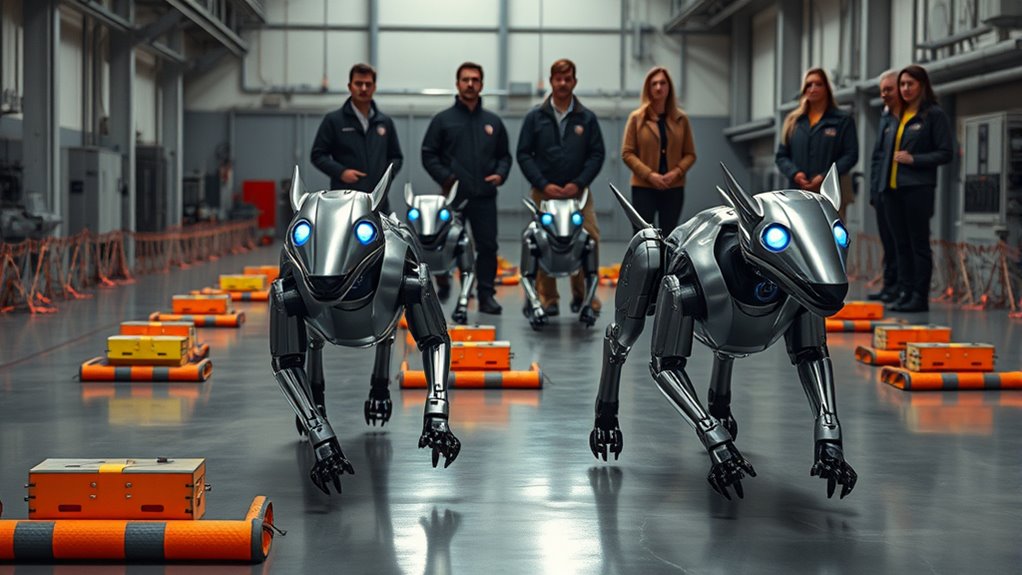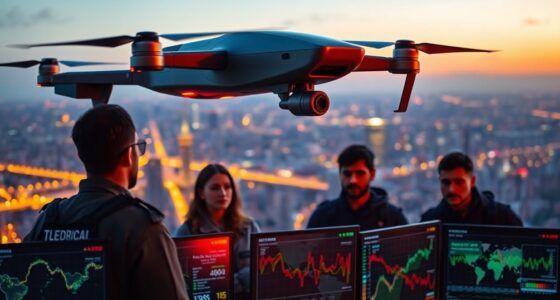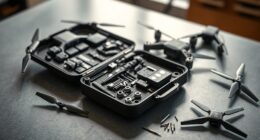Robot dogs have excelled in bomb disposal trials, showcasing their remarkable skills. These innovative machines can navigate stairs, open doors, and handle explosive devices autonomously. Equipped with advanced sensors and AI drones, they enhance operational safety by minimizing human involvement in dangerous tasks. Their capabilities improve threat detection and guarantee accurate bomb disposal. As these technologies evolve, you’ll discover even more about their impact on military operations and public safety in the future.
Key Takeaways
- Trials evaluated robot dogs’ capabilities in bomb disposal, focusing on reducing risks to personnel and enhancing technology.
- Equipped with advanced sensors, robot dogs autonomously navigate environments and identify explosive devices.
- The robots can safely deploy disruptors to detonate or disarm bombs without human intervention.
- Collaboration with AI drones enhances situational awareness and threat detection during operations.
- Technological innovations improve operational safety and effectiveness in military operations, adapting to evolving threats.
Overview of the Trials
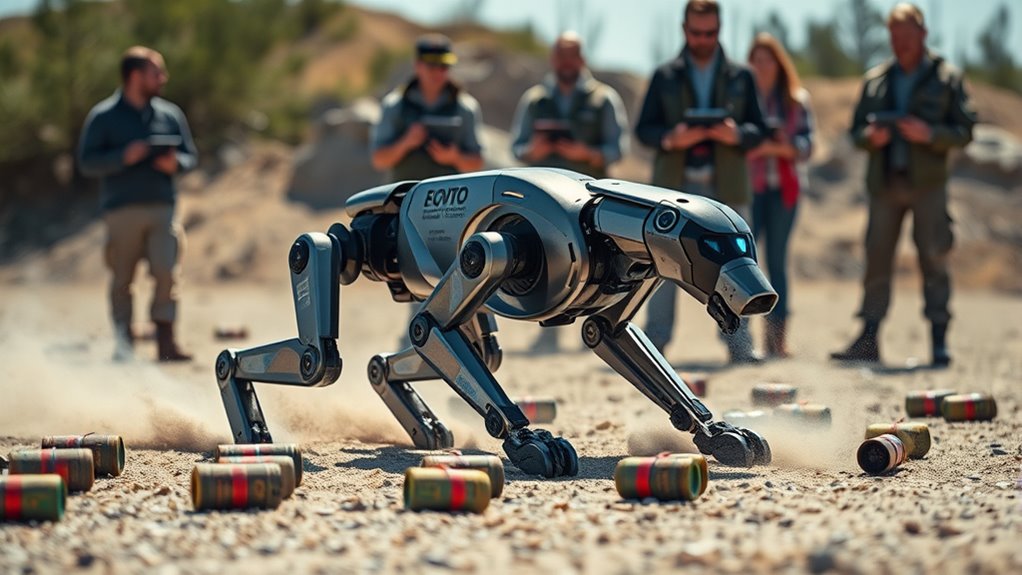
As the trials unfolded over four days, they aimed to evaluate how effectively robots, particularly robot dogs, could enhance bomb disposal operations.
You’d witness a collaboration between the Defence Science and Technology Laboratory, L3Harris, Marlborough Communications Ltd, and AeroVironment, all focused on improving Explosive Ordnance Disposal capabilities.
The objective was clear: reduce risks to personnel while advancing technology.
The goal remains focused: minimizing personnel risks while pushing the boundaries of technological advancement.
During the trials, robot dogs took center stage, equipped with advanced sensors and AI drones, performing tasks like opening doors and maneuvering stairs autonomously.
Each scenario simulated real-world challenges, testing the robots’ abilities to inspect and identify improvised explosive devices.
The outcomes could pave the way for safer, more efficient bomb disposal operations, aligning with national security goals.
Capabilities of Robot Dogs
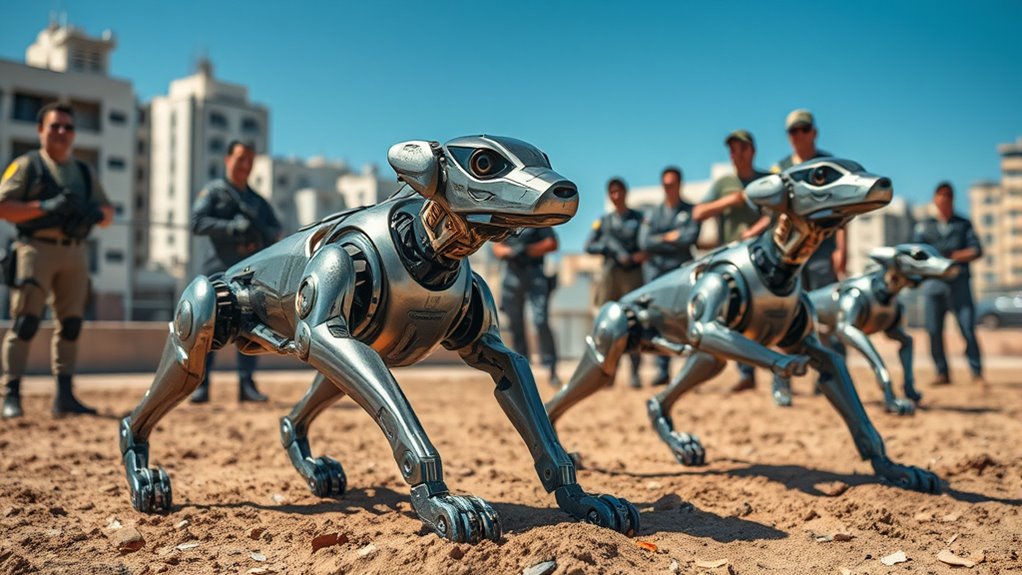
Robot dogs showcase remarkable capabilities that considerably enhance bomb disposal operations. They navigate stairs autonomously and can open doors, granting access to restricted areas.
Their independence in movement allows them to traverse various surfaces, reaching potential threats in challenging environments. Equipped with advanced sensors, these robots identify and classify explosive devices while performing delicate maneuvers autonomously, reducing the need for human intervention.
They deploy disruptors to safely detonate or disarm bombs, improving operational efficiency and minimizing risks to military personnel. Collaborating with AI-powered drones, they enhance situational awareness and threat detection.
Technological Innovations in Bomb Disposal
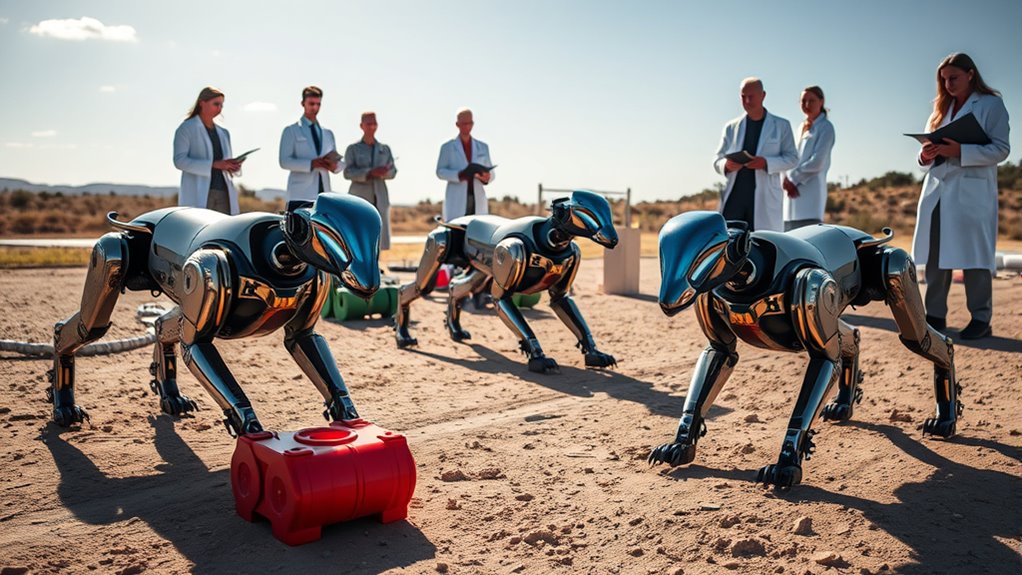
The landscape of bomb disposal is rapidly transforming through technological innovations that enhance safety and efficiency.
Modern robotics minimize human intervention in dangerous environments, while AI-integrated sensors allow for remote threat classification.
Collaborative partnerships between government and industry drive the development of sophisticated technologies, enabling robots to navigate various terrains and perform complex tasks.
Autonomous drones also play an essential role, enhancing operational efficiency with threat detection and monitoring.
As these technologies evolve, they provide high-resolution feedback, improving accuracy in bomb disposal operations.
This shift not only reduces human risk but also increases response times, ultimately contributing to better public safety and more efficient threat assessments in complex scenarios.
Enhancing Operational Safety
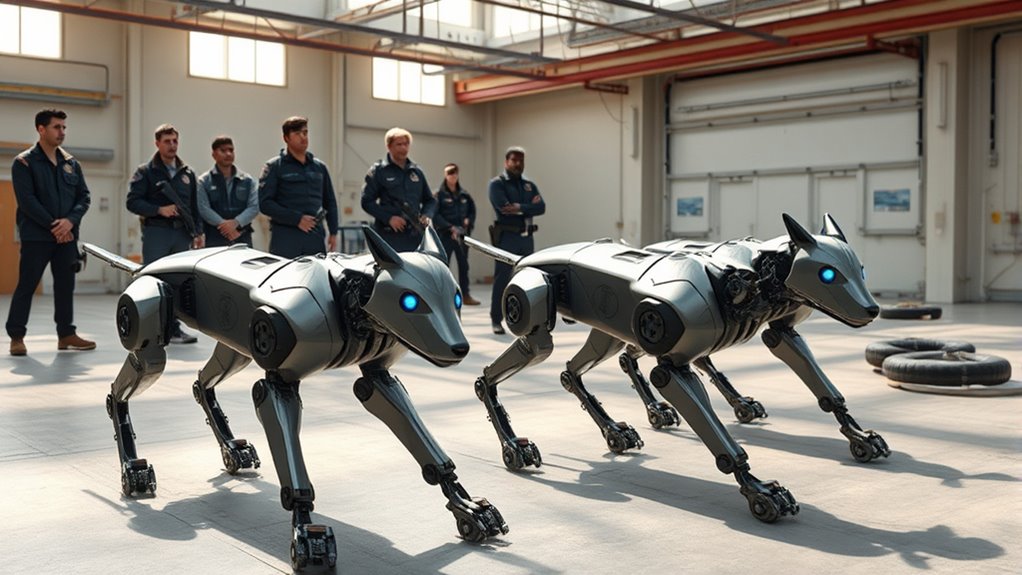
Technological advancements in bomb disposal have greatly improved operational safety, allowing teams to engage with dangerous situations from a distance.
With the use of robots and drones, you can minimize human exposure to threats, performing more tasks remotely. These advanced machines enable precise movements, reducing risks associated with manual handling.
AI-powered systems enhance efficiency by quickly identifying and classifying potential threats. Adhering to safety protocols, like grounding procedures, is essential, especially when dealing with sensitive explosives.
Continuous training in best practices guarantees safe operations, even in high-risk environments. By integrating these technologies, you not only protect personnel but also enhance the overall effectiveness of bomb disposal missions, securing a safer outcome for everyone involved.
Collaborative Efforts in Development
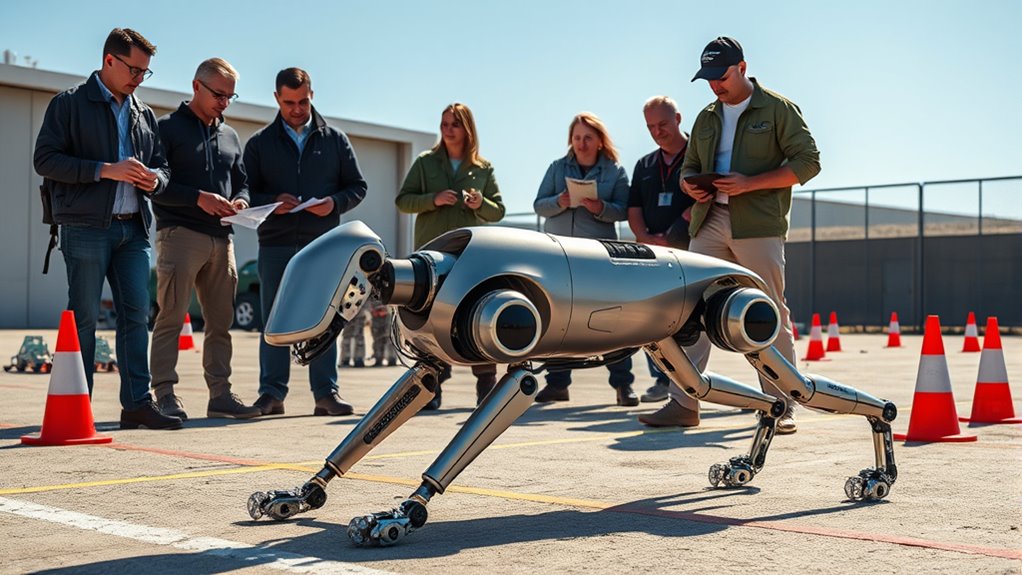
As collaboration between the UK Ministry of Defense and industry partners deepens, the development of advanced robotics for bomb disposal is accelerating.
By combining military and commercial expertise, you’re witnessing a significant enhancement in the effectiveness of robot dogs during bomb disposal scenarios.
The Defence Science and Technology Laboratory (Dstl) leads rigorous trials to test these innovations, ensuring that they’re equipped with cutting-edge AI-enabled sensors for threat classification and navigation.
The quadruped design provides mobility in diverse environments, allowing the robots to perform autonomous tasks while reducing human risk.
This collaborative effort not only supports national security but also promotes technological growth, showcasing a commitment to developing tools that improve operational efficiency and safety in hazardous situations.
Future Implications for Military Operations
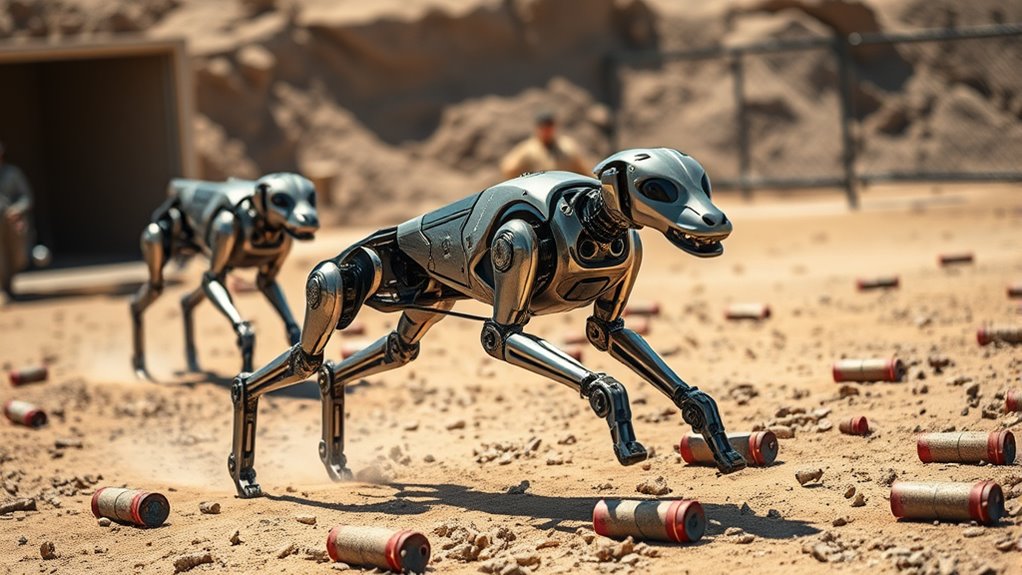
While advancements in robotics are transforming military operations, the future implications of deploying robot dogs in bomb disposal are particularly profound.
You’ll find that these robots enhance safety by keeping personnel out of harm’s way, drastically reducing risks during operations. Their ability to navigate complex environments and perform tasks autonomously boosts operational efficiency, minimizing disruptions to public activities.
With advanced sensors and AI integration, they can accurately detect threats, ensuring precise interventions. As they adapt to evolving military needs, these robots can be upgraded with new capabilities, making them versatile for various scenarios.
Equipped with advanced sensors and AI, these robots excel in threat detection and can evolve to meet diverse military challenges.
Ultimately, the deployment of robot dogs not only improves military effectiveness but also fosters greater public trust in national security measures.
Transforming Explosive Ordnance Disposal

The integration of advanced robotics is revolutionizing explosive ordnance disposal (EOD) by enhancing safety and efficiency in critical operations.
You’ll see robot dogs and AI-powered drones taking on dangerous tasks, minimizing risks for human operators. These robots excel in detecting and defusing bomb threats, while portable X-ray systems provide essential insights into explosive devices before intervention.
Tools like projected water disruptors safely disable bombs without detonating them. In addition, international collaboration fuels innovation, ensuring EOD practices remain effective and environmentally conscious.
As technology advances, EOD operators undergo specialized training to stay adept at handling new threats, following strict operational procedures. This transformation makes EOD operations safer, more efficient, and increasingly sustainable for future challenges.
Frequently Asked Questions
How Long Did the Robot Dog Trials Last?
The robot dog trials lasted four days. This duration allowed you to witness thorough testing of various tasks, showcasing the integration of multiple robotic technologies.
You’d see robots performing precision tasks autonomously while maneuvering challenging environments. The trials were essential in demonstrating the effectiveness of these technologies in reducing risks to personnel during bomb disposal operations.
Which Specific Models of Robot Dogs Were Used?
Isn’t it fascinating how technology advances?
In these trials, one of the standout models was Boston Dynamics’ “Spot,” known for its agility and autonomy. You’d also see other advanced robots equipped with AI-enabled sensors for threat identification.
These models worked together, showcasing their capabilities in maneuvering through complex environments and performing tasks usually reserved for human operatives.
It’s incredible to think about how these innovations could redefine safety in bomb disposal operations.
What Types of Explosives Were Tested During the Trials?
During the trials, you’d find that improvised explosive devices (IEDs) were the primary focus.
These explosives posed significant threats, requiring innovative approaches for detection and disposal.
You’d see robots equipped with advanced sensors to identify these threats and specialized tools for safe disruption.
The goal was to enhance operational efficiency while minimizing risks to human operatives.
How Were the Robots Controlled Remotely?
The robots were controlled remotely using advanced control systems that integrate real-time feedback from their sensors.
You’d be able to monitor threats and make strategic decisions without being physically present.
With autonomous navigation capabilities, the robots could navigate complex environments, while AI algorithms guaranteed precise movements for delicate tasks.
This remote operation reduces risks for human operators, allowing you to manage potentially dangerous situations safely and effectively from a distance.
What Is the Cost of Implementing These Technologies?
When considering the cost of implementing robot technologies, you’ll find initial investments can be substantial. For instance, a robot dog might cost around $328,000, while simpler models are available for about $31,000.
You’ve also got to factor in long-term expenses like maintenance, upgrades, and training personnel to operate these systems. While the upfront costs are high, potential long-term savings and efficiency gains could make it worthwhile in the long run.
Conclusion
In the dance between technology and safety, robot dogs are stepping up as agile partners in bomb disposal. With their advanced capabilities, they’re turning once perilous missions into calculated performances, minimizing risks for human operatives. As these mechanical marvels evolve, they’re not just tools; they’re the sentinels of tomorrow’s military operations, paving the way for a future where explosive ordnance disposal becomes a seamless waltz instead of a dangerous gamble. The horizon shines bright with possibilities.
